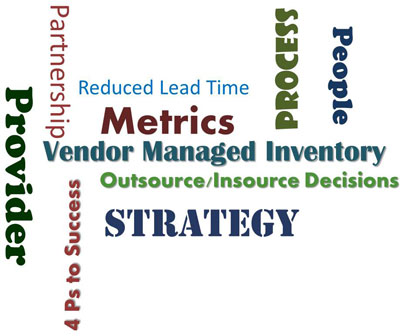
Before talking about the keys to achieving VMI (vendor managed inventory) success, the question is: what is VMI? VMI is a process where the supplier places purchase orders for their customers to agreed-upon metrics.
Why VMI?
I’m a supply chain and operations consultant and former executive and have implemented VMI programs which have resulted in significant improvements in terms of the customer, cash and cost. For example, during my tenure at PaperPak, an adult incontinence manufacturing company, we achieved the following successes with our #1 customer:
- Recognized by #1 customer as “supplier of the year”
- Increased sales
- Became “part of the customers’ organization”
- Doubled inventory turns
- Improved customer service to 98%+
- Reduced lead times and improved costs
While supporting customers on VMI through several business condition changes including a merger/ acquisition, cash crisis, turnaround, and investment buyout and several VMI changes including software changes, process changes, and insource/ outsource decisions, there were several up’s and down’s, successes and mistakes. Through these trials and tribulations, the keys to success emerged – the 4 P’s – people, process, partnership and provider.
- The first key to success is peopleThe right people are your #1 asset. First, senior leadership makes or breaks any vendor managed inventory program. Senior leadership must provide commitment and support, have a high level understanding of the value that can be achieved through a VMI program and be able to explain the whys. Understanding and being able to explain the whys behind a VMI program is key so that implementers’ individual goals are tied to the big picture / strategy and tools and support are provided. For example, since PaperPak had senior leadership support, the customer and bottom-line impacts were understood and valued, which resulted in the appropriate resources and funding allocations.Second, the right VMI planner is critical. After putting the wrong person in the role, I quickly discovered the importance of finding the right person with the right skillsets for the VMI planner position. Our service levels suffered until we found a person with an analytical skillset. Ideally, the VMI planner will be analytical, enjoy the optimization game, self confident (because when you are optimizing among variables, it is similar to being at the center of a firing range), customer focused, has a passion for details and follow-up yet can see the bigger picture.Lastly, there are other people integral to VMI success – the support functions such as customer service, planning, sales, and information services. To achieve success, it takes a team.
- The second key to success is partnershipsThis is back to point #1 – the right people; however, this is in terms of the right people and partnerships with customers and suppliers. The definition of a partnership is simple – ‘win-win’. To create a successful VMI program, it requires a close partnership with your customer. The ingredients for a successful partnership are trust, ability to find and create win-win ideas, collaboration on forecasts, goal setting and metrics scorecard reviews. The same holds true for your suppliers. View your customers and your suppliers as an extension of your company and supply chain. With a partnership, you should be able to turn 1 + 1 into 5, meaning your returns will be exponential over what you will achieve on your own.
- The third key to success is processTo ensure flawless execution and customer service, process is king. Rigorously following the traditional plan, do, check, act model can yield significant results. It has been shown that although the majority of people spend the majority of their time on the “do” of plan, do, check, act, the successful implementers spend a very small portion of time (10%) on “doing”. Instead, it is plan (70%), do (10%), check (15%), and act (5%). As this implies, follow-up/ audit is also essential for success – it is how metrics review, best practices and continual improvement is built into the process.
- The fourth key to success is providerThe software tools and provider supports your people and process. For VMI, this can include EDI (electronic data interchange) and VMI software tools. After utilizing multiple software suppliers and discovering the keys to success through trials and tribulations, it is apparent that bells and whistles do not = success. Instead, what really matters are the following: a partnership approach, the right combination of functionality, flexibility and cost and forecast features. For example, PaperPak partnered with Prescient to achieve the results listed under “why VMI.”
After these fundamentals are in place, you can drive additional efficiencies and customer intimacy through continuing to focus on the 4 P’s. When linking the people and process elements, think about utilizing VMI as a business strategy and link strategy with execution. The benefits will continue to grow as the elements of VMI are implemented throughout the supply chain. As your VMI program grows, your results will grow – increased customer partnerships and intimacy, reduced costs and improved cash flow.
Did you like this article? Continue reading on this topic:
4 Keys to VMI Success
VMI: What are the Benefits?
VMI: Supply Chain Collaboration on Steroids
VMI: Do You Need Software?
VMI: Success Depends on People


